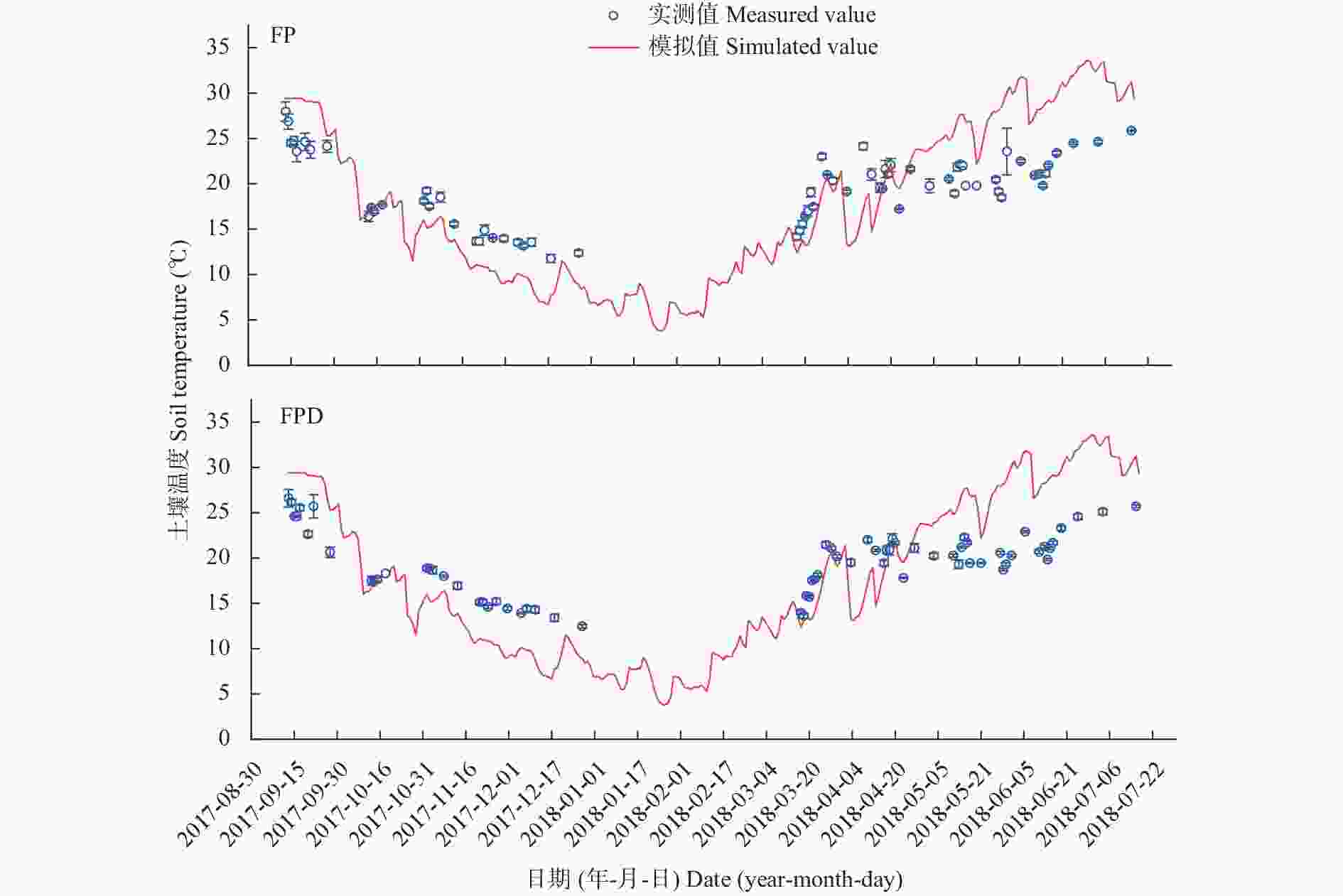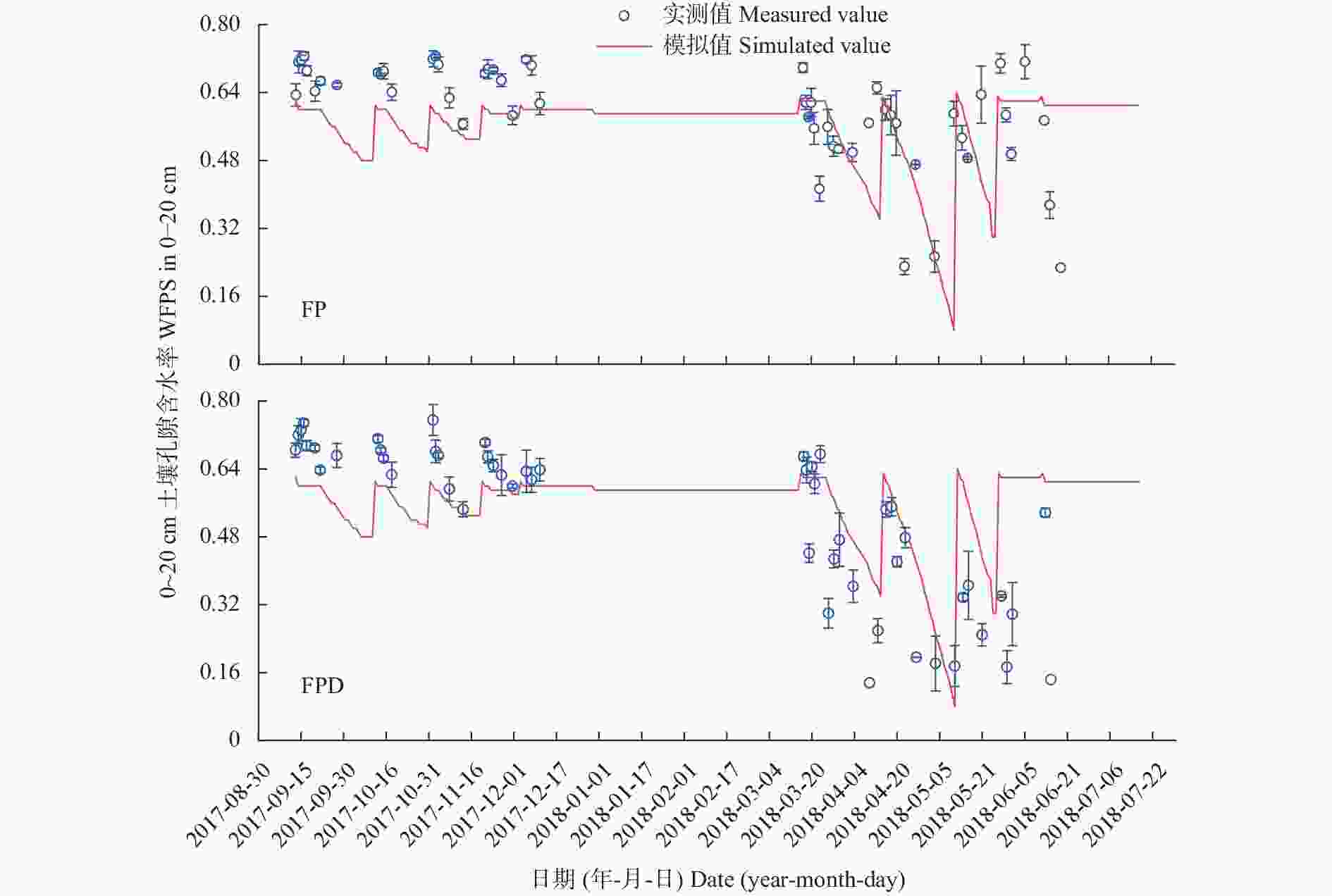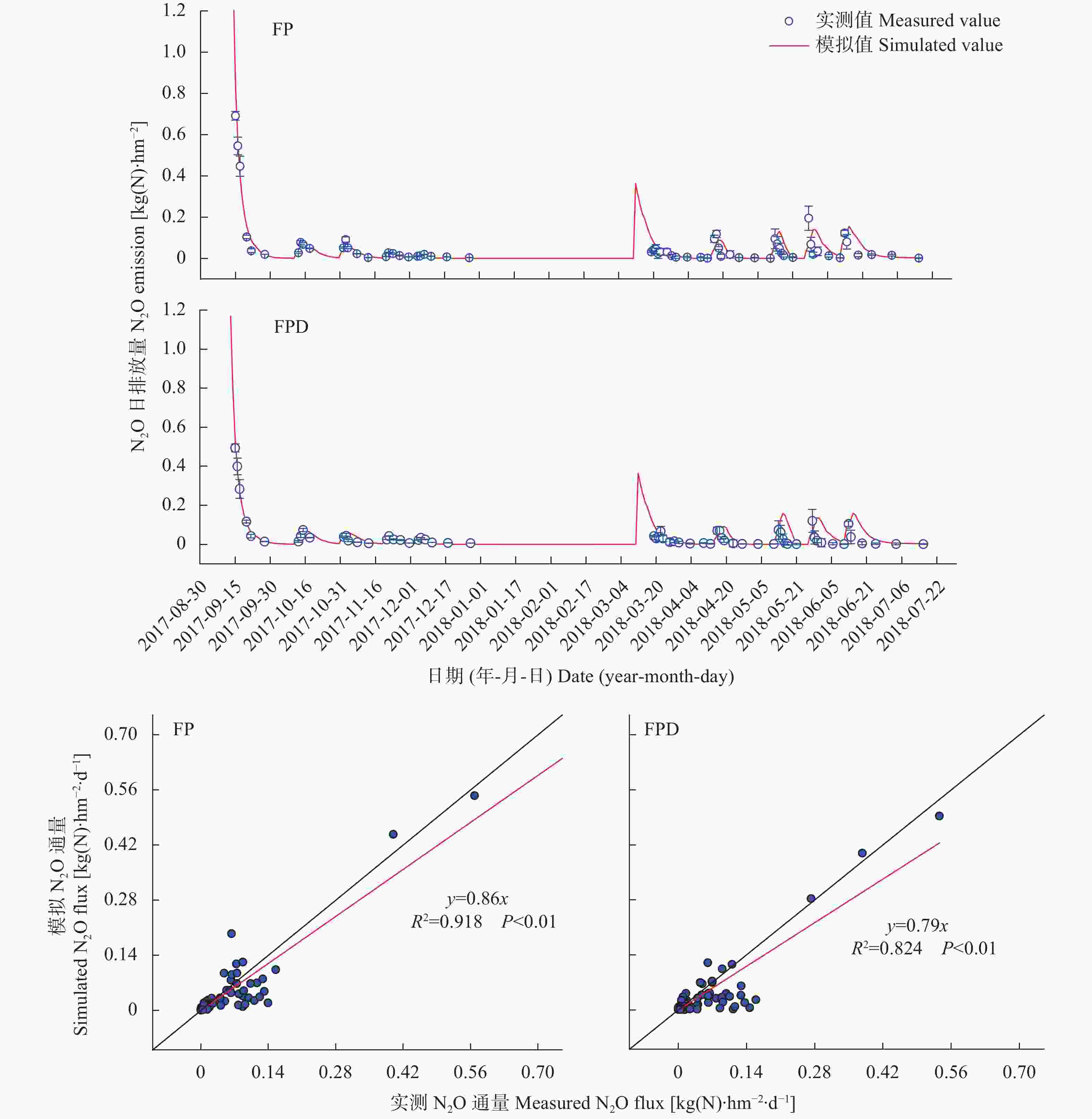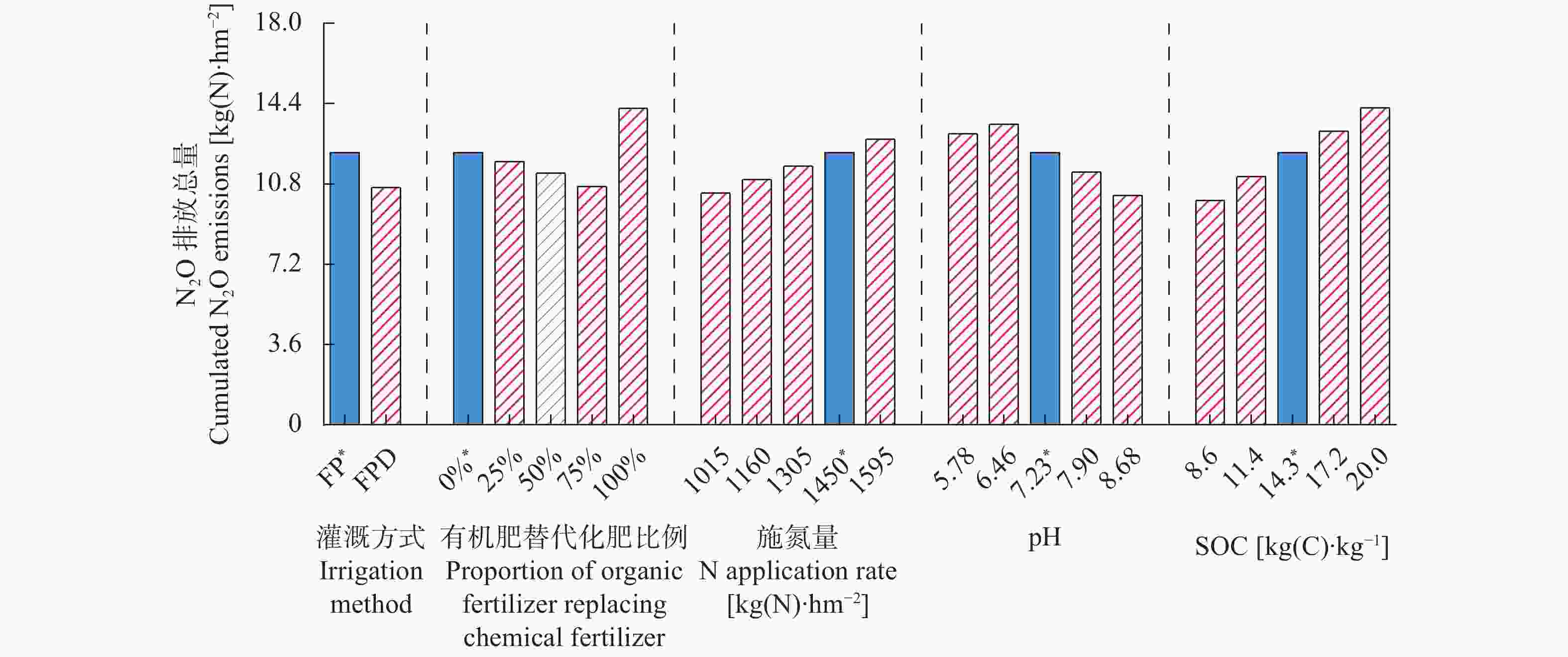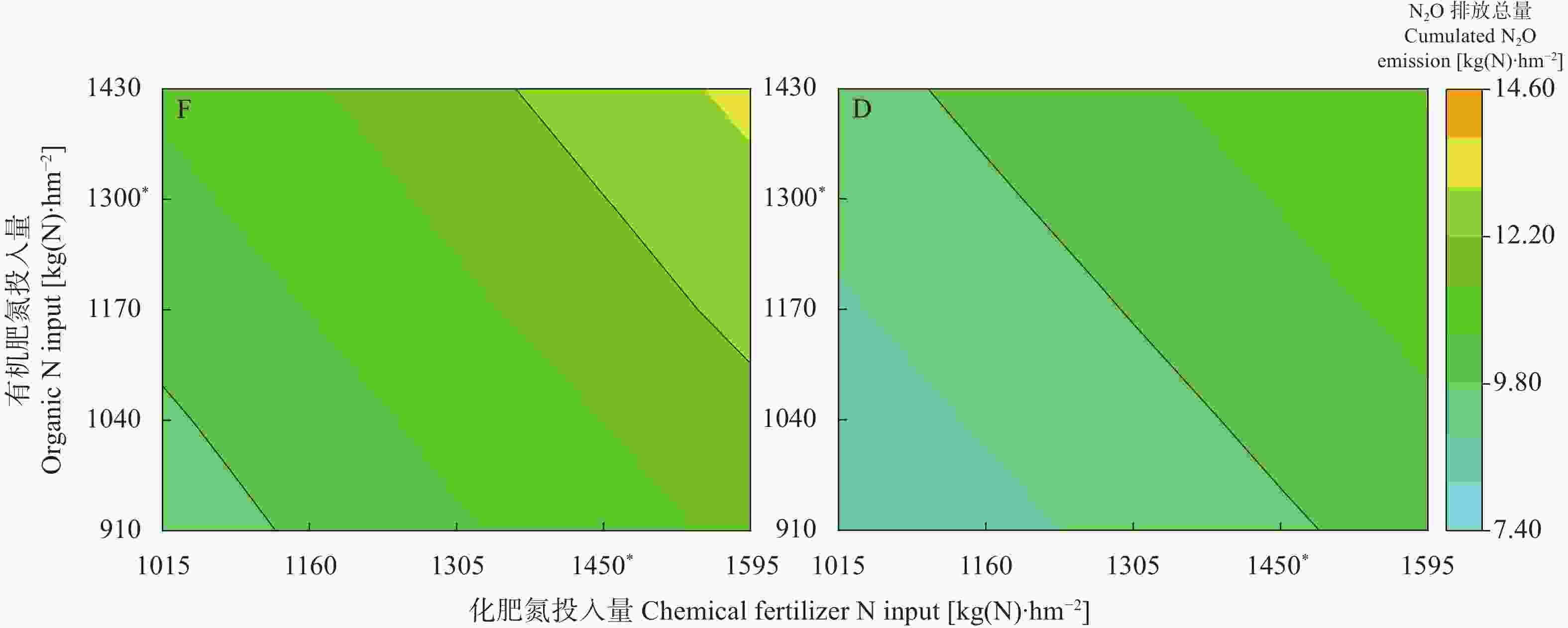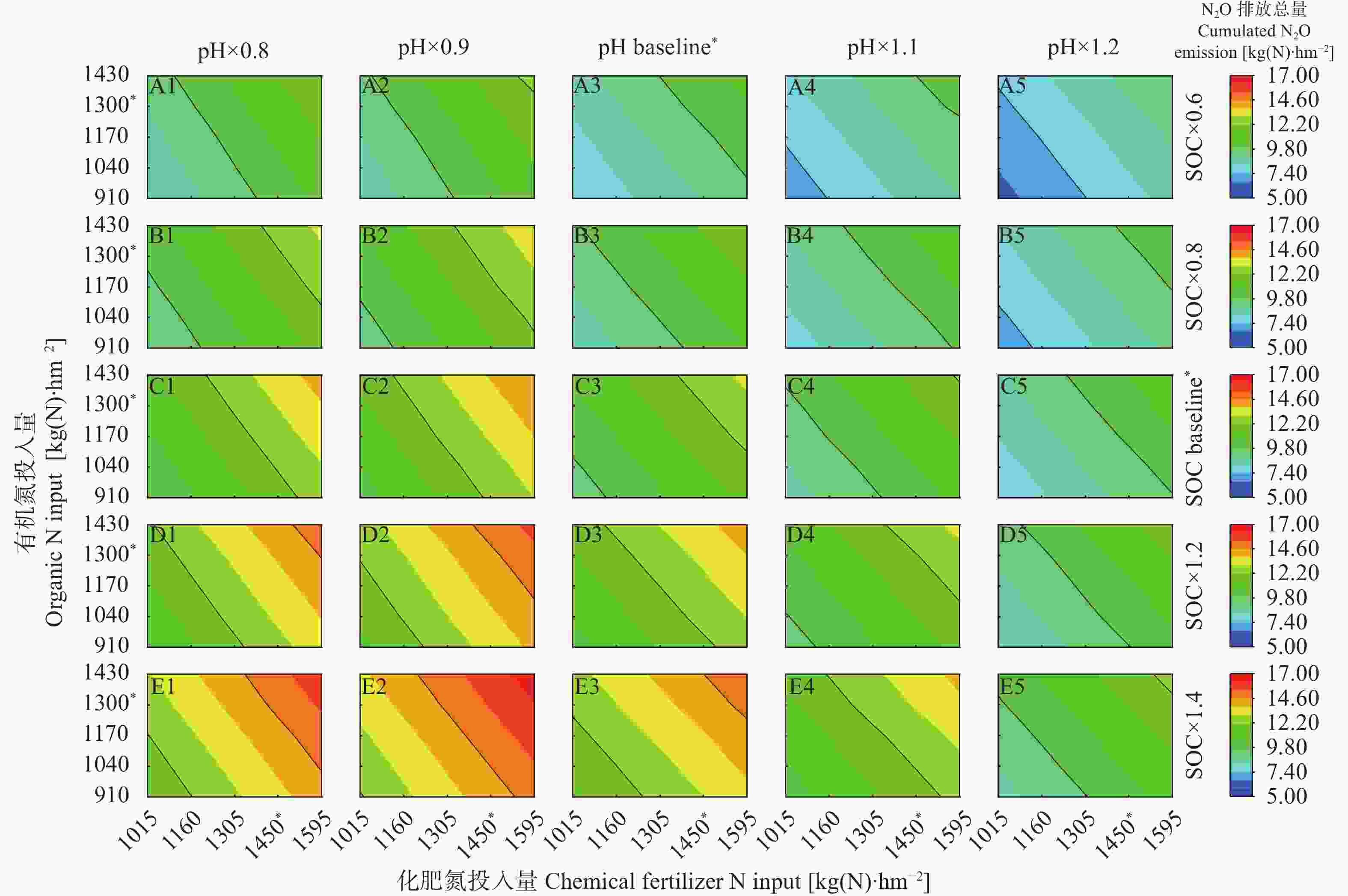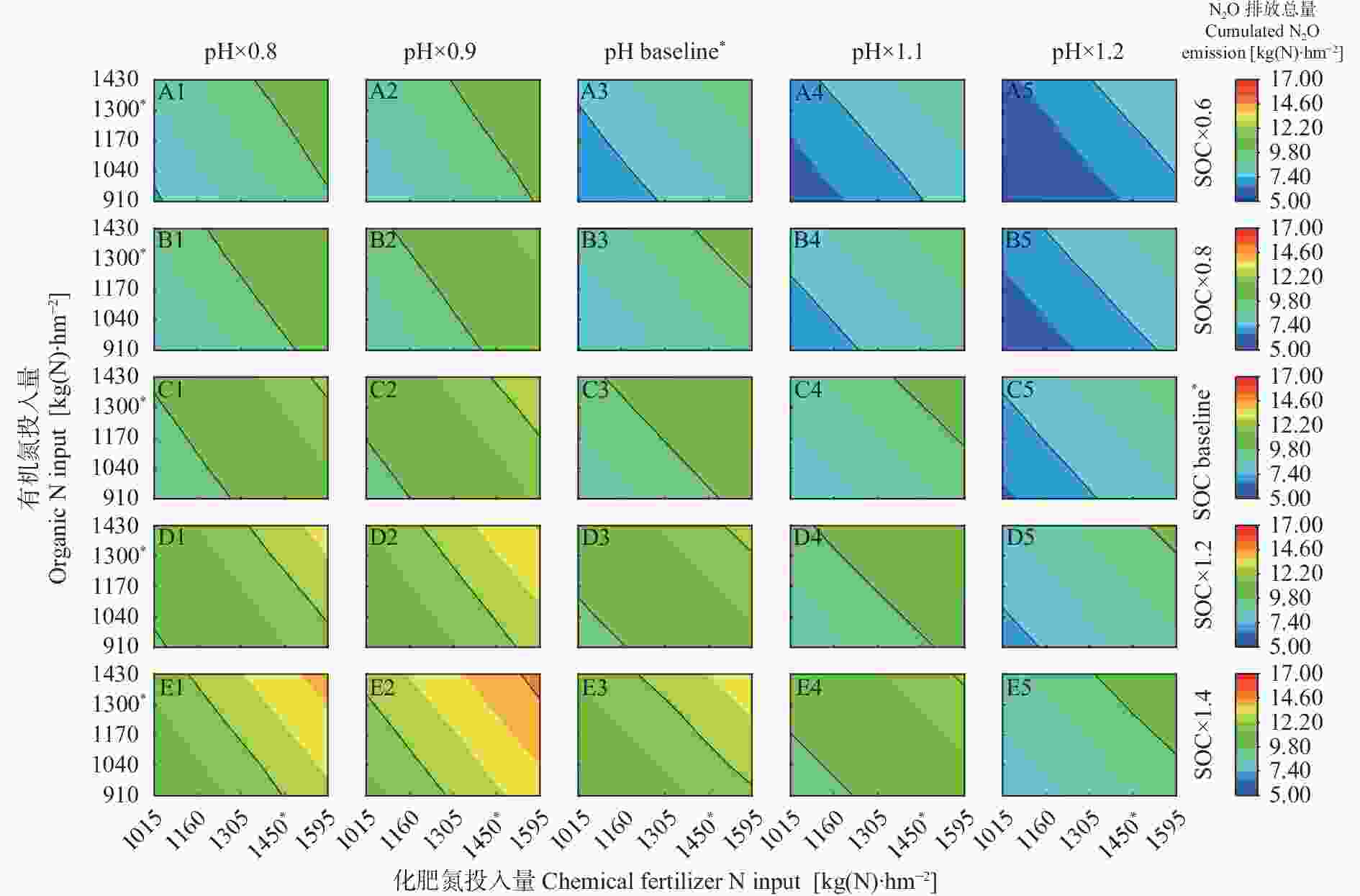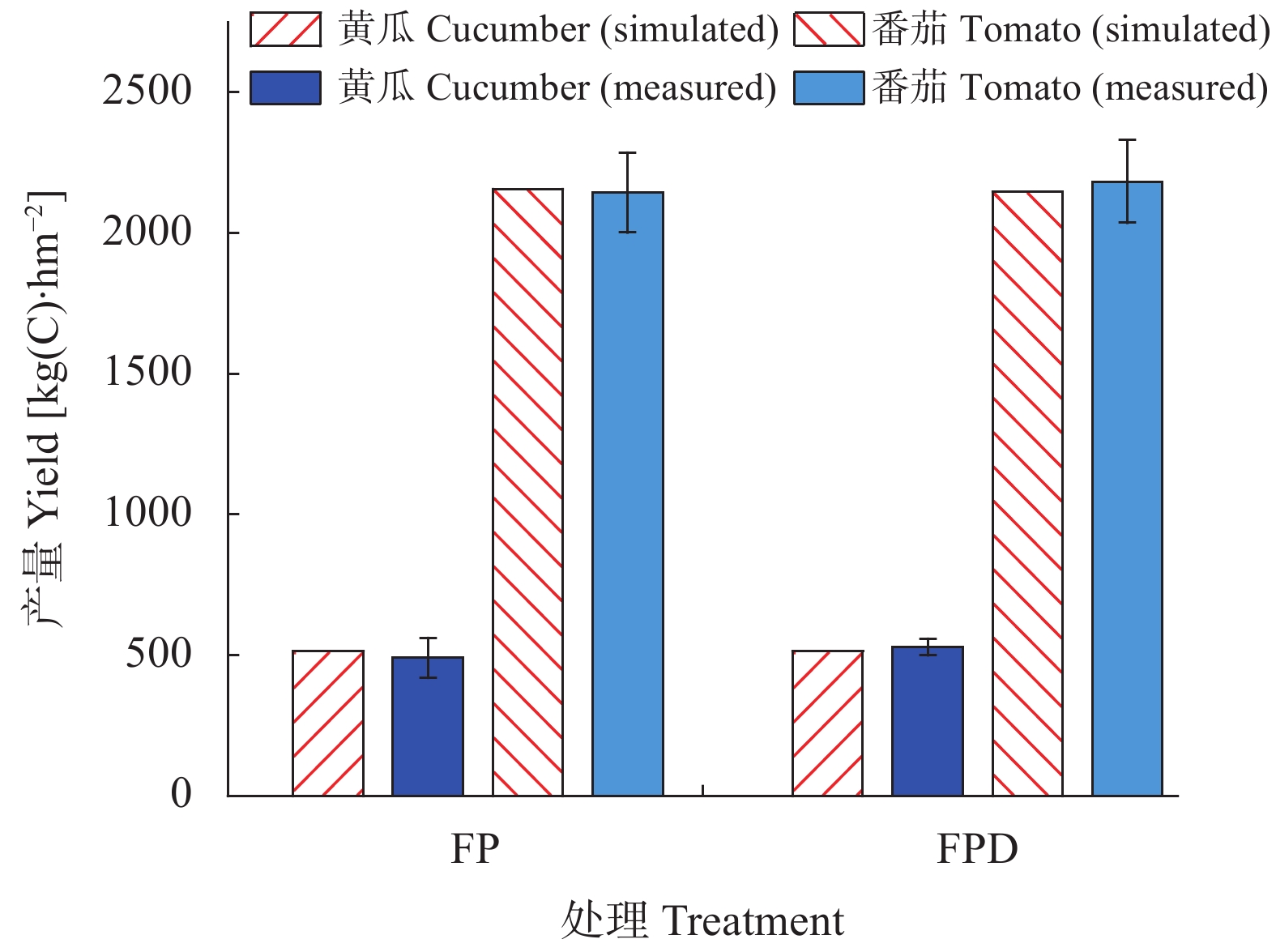Assessment of the N2O emission reduction potential in greenhouse vegetable fields based on the DNDC model
-
摘要: 设施菜地因水肥投入高而导致大量N2O排放已成为当前研究热点。N2O作为主要温室气体之一, 探寻N2O减排潜力不仅可为设施菜地碳减排方案的制定提供一定参考, 还可为实现我国“双碳”目标提供科学依据。本研究以京郊典型设施黄瓜-番茄系统为研究对象, 通过田间试验与DNDC模型相结合的方法, 基于田间观测数据对模型进行校验, 然后以农民常规种植模式为基线情景, 改变田间管理措施(灌溉方式、施氮量、有机肥替代化肥等)和调控土壤理化性质[土壤有机碳(SOC)、pH等]为替代情景, 运用DNDC模型通过1250次模拟得到单一情景和多组合情景下N2O排放量, 并评估其减排潜力。结果表明, DNDC模型能够较好地模拟设施菜地土壤温湿度、蔬菜产量和N2O排放量。基线情景下N2O排放总量为12.18 kg(N)∙hm−2。单因子情景分析表明, 设施菜地N2O减排潜力变幅为12.23%~17.58%。敏感性指数显示N2O排放对土壤pH调控和化肥减施的响应比对其余单因子较为敏感, 其中相比于基线情景, 1.2倍土壤pH情景和减施30%化肥情景N2O排放量分别降低15.60%和14.86%。多组合因子情景表明, 与基线情景相比, 同时采用滴灌、减少30%的化肥施氮量和减施30%有机肥组合情景, 可降低31.69%的N2O排放。而相同组合在低SOC及高pH的土壤情景中N2O减排潜力可进一步降低, 达到55.58% [6.77 kg(N)∙hm−2]。可见, DNDC模型可较好地模拟田间环境, 克服田间试验中有限的处理设置和较高的监测成本等局限性, 从而为设施菜地N2O排放定量评估和减排评价提供了一个较好的解决方案。DNDC对设施菜地N2O排放的单因子情景和组合情景的模拟结果表明, 结合土壤理化性质调控和水肥管理措施优化具有较大的N2O减排潜力。Abstract: The large amount of N2O emission associated with high water and fertilizer inputs in greenhouse vegetable fields has become a salient issue. As N2O is one of the major greenhouse gases, the research on reducing N2O emissions can provide not only a reference for the formulation of carbon reduction plans for greenhouse vegetable fields but also a scientific basis to realize China’s “dual carbon” target. In this study, the N2O emission of a typical greenhouse cucumber-tomato system in the Beijing suburbs was studied by using field monitoring and the DNDC model. The model was calibrated using field observations, and farmers’ conventional practices were set as the baseline scenario. The scenarios with changes in field management practices (e.g., irrigation method, N application rate, and replacement of chemical fertilizer by organic fertilizer) and regulation of soil physicochemical properties (soil organic carbon, pH, etc.) were set. N2O emissions were obtained from 1250 simulations of the DNDC model for single scenario and multiple combinations of scenarios, and their emission reduction potentials were evaluated. The results showed that the DNDC model can simulate the soil temperature, soil water-filled pore space, vegetable yield, and N2O emissions in greenhouse vegetable fields. The total N2O emissions in the baseline scenario were 12.18 kg(N)∙hm−2. The variation in the N2O reduction potential of greenhouse vegetable fields ranged from 12.23% to 17.58% under the single-factor scenario. The sensitivity index showed that N2O emissions were more sensitive to soil pH regulation and fertilizer reduction than to the other scenarios, with N2O emissions (10.28 kg(N)∙hm−2) reduced by 15.60% and 14.86% for the 1.2-unit-change-in-soil-pH scenario and the 30% fertilizer reduction scenario (10.38 kg(N)∙hm−2), respectively, compared to the baseline. The multiple combination scenarios showed that a reduction of 31.69% in N2O emissions from the baseline could be achieved with a combination of drip irrigation, 30% reduction in chemical N application, and 30% reduction in organic fertilizer. The N2O reduction potential further improved to 55.58% (6.77 kg(N)∙hm−2) for the same combination in the low soil organic carbon and high pH soil scenarios. Overall, the DNDC model can simulate the field environment and overcome the drawbacks of limited treatment settings and high monitoring costs in field experiments, providing a useful method to quantitatively assess and reduce N2O emissions in greenhouse vegetable fields. The combination of regulating soil physicochemical properties and optimizing water and fertilizer management can effectively reduce N2O emission in greenhouse vegetable fields.
-
Key words:
- DNDC model /
- Greenhouse vegetable field /
- Emission reduction potential /
- N2O
-
图 3 DNDC模型对不同灌溉施肥方式下设施菜地土壤0~20 cm孔隙含水率的模拟结果
FP: 农民习惯处理; FPD: 滴灌施肥处理。
Figure 3. Simulation results of 0−20 cm soil water-filled pore space (WFPS) of greenhouse vegetable system under different irrigation and fertilization treatments by DNDC model
FP: farmer’s conventional treatment; FPD: drip fertigation treatment.
图 5 DNDC模型对不同情景下设施菜地N2O排放总量模拟结果
*代表基线。横坐标为设置的各组情景。SOC为土壤有机碳。FP: 农民习惯处理; FPD: 滴灌施肥处理。
Figure 5. Simulation results of total N2O emissions of greenhouse vegetable system under different scenarios by DNDC model
* represents the baseline scenario. The X-axis is scenario settings. SOC is soil organic carbon. FP: farmer’s conventional treatment; FPD: drip fertigation treatment.
图 7 DNDC 模型对漫灌条件下不同组合情景的设施菜地N2O排放模拟结果
SOC为土壤有机碳; *代表基线, pH基线值为7.23, SOC baseline值为14.3 g(C)∙kg−1。
Figure 7. N2O emission simulation results of greenhouse vegetable system by DNDC model under different combination scenarios under flooding irrigation
SOC is soil organic carbon. * represents the baseline scenario. The baseline vales of pH and SOC are 7.23 and 14.3 g(C)∙kg−1, respectively.
图 8 DNDC 模型对滴灌条件下不同组合情景的设施菜地N2O排放模拟结果
SOC为土壤有机碳; *代表基线, pH基线值为7.23, SOC baseline值为14.3 g(C)∙kg−1。
Figure 8. N2O emission simulation results of greenhouse vegetable system by DNDC model under different combination scenarios under drip irrigation
SOC is soil organic carbon. * represents the baseline scenario. The baseline vales of pH and SOC are 7.23 and 14.3 g(C)∙kg−1, respectively.
表 1 设施黄瓜-番茄轮作周期的灌溉施肥管理表
Table 1. Detailed irrigation and fertilization management for cucumber-tomato rotation in greenhouse
种植季
Planting season项目
Project日期(月-日)
Date (month-day)施肥量
Fertilization rate [kg(N)∙hm−2]灌水量
Irrigation amount (mm)黄瓜季 Cucumber 施有机肥 Organic fertilizer application 09-13 700 — 施基肥 Basal dressing 09-13 710 41.7 第1次追肥 First dressing 10-12 140 32.1 第2次追肥 Second dressing 11-01 140 29.2 第3次追肥 Third dressing 11-20 140 29.2 第4次追肥 Fourth dressing 12-04 70 32.1 番茄季 Tomato 施有机肥 Organic fertilizer application 03-12 800 — 基肥 Basal dressing 03-16 950 29.2 第1次追肥 First dressing 04-15 150 29.2 第2次追肥 Second dressing 05-12 150 41.7 第3次追肥 Third dressing 05-27 150 41.7 第4次追肥 Fourth dressing 06-12 150 41.7 表 2 温室黄瓜-番茄种植系统的DNDC模型输入参数汇总表
Table 2. Summary table of input parameters of DNDC model of cucumber-tomato planting system in greenhouse
参数 Parameter 黄瓜 Cucumber 番茄 Tomato 土壤表层有机碳 Surface soil organic carbon content [g(C)∙kg−1] 14.3 田间持水量 Field capacity (soil water-filled pore space, WFPS) 0.6 土壤质地 Soil texture 粉壤土 Silt loam 黏粒含量 Clay fraction 0.14 容重 Soil bulk density (g∙cm−3) 1.29 萎蔫点 Soil WFPS at wilting point 0.16 孔隙度 Porosity 0.65 目标产量 Max. biomass production [kg(C)∙hm−2] 560.00 1660.68 成熟时生物量分配比例
Biomass fraction at harvest果 Grain 0.65 0.36 叶 Leaf 0.15 0.22 茎 Stem 0.15 0.22 根 Root 0.05 0.20 成熟时C/N比值
C/N ratio at harvest果 Grain 12.00 26.00 叶 Leaf 11.97 26.00 茎 Stem 11.33 26.00 根 Root 25.00 45.00 生长积温 Thermal degree days for maturity (℃) 1000 1400 需水量 Water demand [g(water)∙g−1(DM)] 500 300 表 3 设施菜地N2O减排措施
Table 3. N2O emission reduction measures of greenhouse vegetable fields
研究方法
Research method种植时间(年-月)
Period (year-month)减排措施
Emission reduction measure减排效果
Emission reduction
effect (%)参考文献
Reference黄瓜-芹菜(Apium graveolens L.)田间试验
Cucumber-celery field experiment2016-03—2016-07 滴灌、减施50%化肥
Drip irrigation, 50% chemical fertilizer reduction35.2~57.5 [13] 黄瓜-番茄田间试验
Cucumber-tomato field experiment2017-09—2017-12 滴灌、减施50%化肥
Drip irrigation, 50% chemical fertilizer reduction23.5~47.2 [11] 芹菜-番茄田间试验
Celery-tomato field experiment2009-10—2021-02 有机肥替代0%、25%、50%、75%、100%化肥
Organic fertilizer replacing 0%, 25%, 50%, 75%, 100%
chemical fertilizer66.3~85.1 [29] 番茄田间试验
Tomato field experiment2016-09—2016-12 有机肥替代0%、50%、100%化肥
Organic fertilizer replacing 0%, 50%, 100% chemical fertilizer45.1~33.2 [30] 室内培养
Indoor culture— 调整pH至5.5~7.5 Adjusting pH to 5.5−7.5 42.6~70.1 [31] 室内培养
Indoor culture— 调整pH至5.1~8.15 Adjusting pH to 5.1−8.15 18.8~42.3 [32] Meta分析
Meta-analysis— 土壤有机碳变化范围为6.27~24.1 g∙kg−1
The variation range of soil organic carbon was 6.27−
24.1 g∙kg−148.6% [33] 表 4 DNDC模型土壤基础性质及管理措施情景设置
Table 4. Soil basic properties and management measures scenarios setting in DNDC model
项目 Item 情景设置 Scenario 单位 Unit 值 Value 灌溉方式
Irrigation method滴灌、漫灌*
Flood irrigation, drip irrigation— — 有机肥替代化肥比例
Proportion of organic fertilizer
replacing chemical fertilizer在基准线上有机肥替代一定比例的化肥
Organic fertilizer replacing a certain proportion of chemical
fertilizer based on the baseline— 0%*, 25%, 50%, 75%, 100% 化肥施氮量
Chemical-N application rate在基准线上减少10%、20%、30%施氮量或提高10%
Reduce nitrogen application by 10%, 20%, 30% or increase it by 10% based on
the baselinekg(N)∙hm−2 1015, 1160, 1305, 1450*, 1595 有机肥施氮量
Organic-N application rate在基准线上减少10%、20%、30%施氮量或提高10%
Reduce nitrogen application by 10%, 20%, 30% or increase it by 10% based on
the baselinekg(N)∙hm−2 910, 1040, 1170, 1300, 1430 酸碱度
pH在基准线上提高或减少10%、20%土壤酸碱度
Increasing or decreasing 10%, 20% soil pH based on baseline— 5.78, 6.46, 7.23*, 7.90, 8.68 土壤有机碳含量
Soil organic carbon content在基准线上提高或减少20%、40%土壤有机质含量
Increasing or decreasing 20%, 40% soil organic matter content based on baselineg(C)∙kg−1 8.6, 11.4, 14.3*, 17.2, 20.0 *代表基线情景。* represents the baseline scenario. 表 5 基于DNDC模型的设施菜地系统N2O排放总量敏感性指数
Table 5. Sensitive indexes of total N2O emissions of greenhouse vegetable system based on DNDC model
输入参数 Parameter 情景设置 Scenario setting 敏感性指数 Sensitive index 灌溉方式 Irrigation method 滴灌、漫灌 Flood irrigation, drip irrigation — 有机肥替代化肥比例
Proportion of organic fertilizer replacing chemical fertilizer0~100% 0.466 化肥施氮量 Nitrogen application rate 1015~1595 kg(N)∙hm−2 0.580 pH 5.74~8.62 0.867 土壤有机碳含量 Soil organic carbon content 8.6~20.0 g(C)∙kg−1 0.428 -
[1] WANG L L, LI L L, XIE J H, et al. Managing the trade-offs among yield, economic benefits and carbon and nitrogen footprints of wheat cropping in a semi-arid region of China[J]. Science of the Total Environment, 2021, 768: 145280 doi: 10.1016/j.scitotenv.2021.145280 [2] AZNAR-SÁNCHEZ J A, VELASCO-MUÑOZ J F, LÓPEZ-FELICES B, et al. An analysis of global research trends on greenhouse technology: towards a sustainable agriculture[J]. International Journal of Environmental Research and Public Health, 2020, 17(2): 664 doi: 10.3390/ijerph17020664 [3] 雷豪杰, 李贵春, 丁武汉, 等. 设施菜地土壤氮素运移及淋溶损失模拟评价[J]. 中国生态农业学报(中英文), 2021, 29(1): 38–52LEI H J, LI G C, DING W H, et al. Modeling nitrogen transport and leaching process in a greenhouse vegetable field[J]. Chinese Journal of Eco-Agriculture, 2021, 29(1): 38–52 [4] HU J, GETTEL G, FAN Z B, et al. Drip fertigation promotes water and nitrogen use efficiency and yield stability through improved root growth for tomatoes in plastic greenhouse production[J]. Agriculture, Ecosystems & Environment, 2021, 313: 107379 [5] 江雨倩, 李虎, 王艳丽, 等. 滴灌施肥对设施菜地N2O排放的影响及减排贡献[J]. 农业环境科学学报, 2016, 35(8): 1616−1624 doi: 10.11654/jaes.2016-0109JIANG Y Q, LI H, WANG Y L, et al. Effects of fertigation on N2O emissions and their mitigation in greenhouse vegetable fields[J]. Journal of Agro-Environment Science, 2016, 35(8): 1616−1624 doi: 10.11654/jaes.2016-0109 [6] LIU Z, GAO J, GAO F, et al. Integrated agronomic practices management improve yield and nitrogen balance in double cropping of winter wheat-summer maize[J]. Field Crops Research, 2018, 221: 196−206 doi: 10.1016/j.fcr.2018.03.001 [7] 吴震, 陈安枫, 朱爽阁, 等. 集约化菜地N2O排放及减排−基于文献整合分析[J]. 农业环境科学学报, 2020, 39(4): 707−714 doi: 10.11654/jaes.2020-0018WU Z, CHEN A F, ZHU S G, et al. Assessing nitrous oxide emissions and mitigation potentials from intensive vegetable ecosystems in China — Meta-analysis[J]. Journal of Agro-Environment Science, 2020, 39(4): 707−714 doi: 10.11654/jaes.2020-0018 [8] NI B, ZHANG W, XU X C, et al. Exponential relationship between N2O emission and fertilizer nitrogen input and mechanisms for improving fertilizer nitrogen efficiency under intensive plastic-shed vegetable production in China: a systematic analysis[J]. Agriculture, Ecosystems & Environment, 2021, 312: 107353 [9] 张婧, 李虎, 王立刚, 等. 京郊典型设施蔬菜地土壤N2O排放特征[J]. 生态学报, 2014, 34(14): 4088−4098ZHANG J, LI H, WANG L G, et al. Characteristics of nitrous oxide emissions from typical greenhouse vegetable fields in Beijing suburbs[J]. Acta Ecologica Sinica, 2014, 34(14): 4088−4098 [10] KIM D G, GILTRAP D, HERNANDEZ-RAMIREZ G. Background nitrous oxide emissions in agricultural and natural lands: a meta-analysis[J]. Plant and Soil, 2013, 373(1/2): 17−30 [11] 雷豪杰, 李贵春, 柯华东, 等. 滴灌施肥对两种典型作物系统土壤N2O排放的影响及其调控差异[J]. 中国农业科学, 2021, 54(4): 768−779 doi: 10.3864/j.issn.0578-1752.2021.04.009LEI H J, LI G C, KE H D, et al. Analysis of impacts and regulation differences on soil N2O emissions from two typical crop systems under drip irrigation and fertilization[J]. Scientia Agricultura Sinica, 2021, 54(4): 768−779 doi: 10.3864/j.issn.0578-1752.2021.04.009 [12] QASIM W, XIA L L, LIN S, et al. Global greenhouse vegetable production systems are hotspots of soil N2O emissions and nitrogen leaching: a meta-analysis[J]. Environmental Pollution, 2021, 272: 116372 doi: 10.1016/j.envpol.2020.116372 [13] 谢海宽, 江雨倩, 李虎, 等. 北京设施菜地N2O和NO排放特征及滴灌优化施肥的减排效果[J]. 植物营养与肥料学报, 2019, 25(4): 591−600 doi: 10.11674/zwyf.18105XIE H K, JIANG Y Q, LI H, et al. N2O and NO emissions from greenhouse vegetable fields and the mitigation efficacy of the optimized fertigation in Beijing[J]. Journal of Plant Nutrition and Fertilizers, 2019, 25(4): 591−600 doi: 10.11674/zwyf.18105 [14] CUI X Q, ZHOU F, CIAIS P, et al. Global mapping of crop-specific emission factors highlights hotspots of nitrous oxide mitigation[J]. Nature Food, 2021, 2(11): 886−893 doi: 10.1038/s43016-021-00384-9 [15] 殷欣, 张明祥, 胡荣桂. 测土配方施肥对湖北省N2O减排的贡献[J]. 环境科学学报, 2016, 36(4): 1351−1358YIN X, ZHANG M X, HU R G. Contribution of soil testing for formulated fertilization to N2O mitigation in Hubei Province[J]. Acta Scientiae Circumstantiae, 2016, 36(4): 1351−1358 [16] LI H, QIU J J, WANG L G, et al. Estimates of N2O emissions and mitigation potential from a spring maize field based on DNDC model[J]. Journal of Integrative Agriculture, 2012, 11(12): 2067−2078 doi: 10.1016/S2095-3119(12)60465-1 [17] 李夏菲, 杨璐, 于书霞, 等. 湖北省油菜测土配方施肥下N2O减排潜力估算[J]. 中国环境科学, 2015, 35(12): 3817−3823 doi: 10.3969/j.issn.1000-6923.2015.12.037LI X F, YANG L, YU S X, et al. Estimation of N2O mitigation potential from rape planting through soil testing and formulated fertilization in Hubei Province[J]. China Environmental Science, 2015, 35(12): 3817−3823 doi: 10.3969/j.issn.1000-6923.2015.12.037 [18] 逯非, 王效科, 韩冰, 等. 农田土壤固碳措施的温室气体泄漏和净减排潜力[J]. 生态学报, 2009, 29(9): 4993−5006 doi: 10.3321/j.issn:1000-0933.2009.09.048LU F, WANG X K, HAN B, et al. Researches on the greenhouse gas leakage and net mitigation potentials of soil carbon sequestration measures in croplands[J]. Acta Ecologica Sinica, 2009, 29(9): 4993−5006 doi: 10.3321/j.issn:1000-0933.2009.09.048 [19] 廖千家骅, 颜晓元. 施用高效氮肥对农田N2O的减排效果及经济效益分析[J]. 中国环境科学, 2010, 30(12): 1695−1701LIAOQIAN J H, YAN X Y. N2O mitigation effects and economic impacts from enhanced-efficiency N fertilizers from fields in China[J]. China Environmental Science, 2010, 30(12): 1695−1701 [20] 李长生, 肖向明, S. Frolking, 等. 中国农田的温室气体排放[J]. 第四纪研究, 2003, 23(5): 493−503 doi: 10.3321/j.issn:1001-7410.2003.05.004LI C S, XIAO X M, FROLKING S, et al. Greenhouse gas emissions from croplands of China[J]. Quaternary Sciences, 2003, 23(5): 493−503 doi: 10.3321/j.issn:1001-7410.2003.05.004 [21] 谢海宽, 江雨倩, 李虎, 等. DNDC模型在中国的改进及其应用进展[J]. 应用生态学报, 2017, 28(8): 2760−2770XIE H K, JIANG Y Q, LI H, et al. Modification and application of the DNDC model in China[J]. Chinese Journal of Applied Ecology, 2017, 28(8): 2760−2770 [22] 邹凤亮, 曹凑贵, 马建勇, 等. 基于DNDC模型模拟江汉平原稻田不同种植模式条件下温室气体排放[J]. 中国生态农业学报, 2018, 26(9): 1291−1301ZOU F L, CAO C G, MA J Y, et al. Greenhouse gases emission under different cropping systems in the Jianghan Plain based on DNDC model[J]. Chinese Journal of Eco-Agriculture, 2018, 26(9): 1291−1301 [23] 吴梦琴, 李成芳, 盛锋, 等. 基于DNDC模型评估湖北省不同稻作系统不同管理措施温室气体排放的周年变化[J]. 中国生态农业学报(中英文), 2021, 29(9): 1480−1492WU M Q, LI C F, SHENG F, et al. Assessment of the annual greenhouse gases emissions under different rice-based cropping systems in Hubei Province based on the denitrification-decomposition (DNDC) model[J]. Chinese Journal of Eco-Agriculture, 2021, 29(9): 1480−1492 [24] 王德营, 姚艳敏, 司海青, 等. 黑土有机碳变化的DNDC模拟预测[J]. 中国生态农业学报, 2014, 22(3): 277−283 doi: 10.3724/SP.J.1011.2014.30983WANG D Y, YAO Y M, SI H Q, et al. Using DNDC model to simulate and predict changes in black soil organic carbon[J]. Chinese Journal of Eco-Agriculture, 2014, 22(3): 277−283 doi: 10.3724/SP.J.1011.2014.30983 [25] DENG J, ZHOU Z X, ZHENG X H, et al. Modeling impacts of fertilization alternatives on nitrous oxide and nitric oxide emissions from conventional vegetable fields in southeastern China[J]. Atmospheric Environment, 2013, 81: 642−650 doi: 10.1016/j.atmosenv.2013.09.046 [26] ZHANG J, LI H, DENG J, et al. Assessing impacts of nitrogen management on nitrous oxide emissions and nitrate leaching from greenhouse vegetable systems using a biogeochemical model[J]. Geoderma, 2021, 382: 114701 doi: 10.1016/j.geoderma.2020.114701 [27] 曹文超, 宋贺, 王娅静, 等. 农田土壤N2O排放的关键过程及影响因素[J]. 植物营养与肥料学报, 2019, 25(10): 1781−1798 doi: 10.11674/zwyf.18441CAO W C, SONG H, WANG Y J, et al. Key production processes and influencing factors of nitrous oxide emissions from agricultural soils[J]. Journal of Plant Nutrition and Fertilizers, 2019, 25(10): 1781−1798 doi: 10.11674/zwyf.18441 [28] 邹建文, 黄耀. 农业管理措施对N2O排放的影响[J]. 农村生态环境, 2002, 18(1): 46−49ZOU J W, HUANG Y. Effect of agricultural management practices on N2O emission of farmlands[J]. Rural Eco-Environment, 2002, 18(1): 46−49 [29] 郝小雨, 高伟, 王玉军, 等. 有机无机肥料配合施用对设施菜田土壤N2O排放的影响[J]. 植物营养与肥料学报, 2012, 18(5): 1073–1085HAO X Y, GAO W, WANG Y J, et al. Effects of combined application of organic manure and chemical fertilizers on N2O emission from greenhouse vegetable soil[J]. Plant Nutrition and Fertilizer Science, 2012, 18(5): 1073–1085 [30] 奚雅静, 刘东阳, 汪俊玉, 等. 有机肥部分替代化肥对温室番茄土壤N2O排放的影响[J]. 中国农业科学, 2019, 52(20): 3625−3636 doi: 10.3864/j.issn.0578-1752.2019.20.013XI Y J, LIU D Y, WANG J Y, et al. Effect of organic partial replacement of inorganic fertilizers on N2O emission in greenhouse soil[J]. Scientia Agricultura Sinica, 2019, 52(20): 3625−3636 doi: 10.3864/j.issn.0578-1752.2019.20.013 [31] 吴涛, 李华, 王振领, 等. pH和含水量对设施菜地土壤N2O排放的影响[J]. 环境化学, 2018, 37(1): 146−153 doi: 10.7524/j.issn.0254-6108.2017021001WU T, LI H, WANG Z L, et al. Effects of pH and water content on N2O emission from greenhouse soil[J]. Environmental Chemistry, 2018, 37(1): 146−153 doi: 10.7524/j.issn.0254-6108.2017021001 [32] 王启, 兰婷, 赖晶晶, 等. 生物质炭添加对不同pH紫色土硝化作用及N2O排放的影响[J]. 土壤, 2020, 52(6): 1170−1178WANG Q, LAN T, LAI J J, et al. Effects of biochar application on nitrification and N2O emission in purple soils with different pH[J]. Soils, 2020, 52(6): 1170−1178 [33] 姚志生, 王燕, 王睿, 等. 中国茶园N2O排放及其影响因素[J]. 农业环境科学学报, 2020, 39(4): 715–725YAO Z S, WANG Y, WANG R, et al. Nitrous oxide emissions and controlling factors of tea plantations in China[J]. Journal of Agro-Environment Science, 2020, 39(4): 715–725 [34] 张钊, 辛晓平. 生物地球化学模型DNDC的研究进展与碳动态模拟应用[J]. 草地学报, 2017, 25(3): 445–452ZHANG Z, XIN X P. Research progress of biogeochemistry model DNDC in carbon dynamic modeling[J]. Acta Agrestia Sinica, 2017, 25(3): 445–452 [35] GILHESPY S L, ANTHONY S, CARDENAS L, et al. First 20 years of DNDC (DeNitrification DeComposition): model evolution[J]. Ecological Modelling, 2014, 292: 51−62 doi: 10.1016/j.ecolmodel.2014.09.004 [36] MACHARIA J M, NGETICH F K, SHISANYA C A. Parameterization, calibration and validation of the DNDC model for carbon dioxide, nitrous oxide and maize crop performance estimation in East Africa[J]. Heliyon, 2021, 7(5): e06977 doi: 10.1016/j.heliyon.2021.e06977 [37] ABDALLA M, SONG X, JU X, et al. Calibration and validation of the DNDC model to estimate nitrous oxide emissions and crop productivity for a summer maize-winter wheat double cropping system in Hebei, China[J]. Environmental Pollution, 2020, 262: 114199 doi: 10.1016/j.envpol.2020.114199 [38] 陈丹艳, 杨振超, 孔政, 等. 设施农业固碳研究现状与展望[J]. 中国农业科技导报, 2018, 20(2): 122–128CHEN D Y, YANG Z C, KONG Z, et al. Current situation and prospect of carbon sequestration facility agriculture[J]. Journal of Agricultural Science and Technology, 2018, 20(2): 122–128 [39] VOGELER I, GILTRAP D, CICHOTA R. Comparison of APSIM and DNDC simulations of nitrogen transformations and N2O emissions[J]. Science of The Total Environment, 2013, 465: 147−155 doi: 10.1016/j.scitotenv.2012.09.021 [40] CUI G, WANG J. Improving the DNDC biogeochemistry model to simulate soil temperature and emissions of nitrous oxide and carbon dioxide in cold regions[J]. Science of The Total Environment, 2019, 687: 61−70 doi: 10.1016/j.scitotenv.2019.06.054 [41] FOLTZ M E, ZILLES J L, KOLOUTSOU-VAKAKIS S. Prediction of N2O emissions under different field management practices and climate conditions[J]. Science of The Total Environment, 2019, 646: 872−879 doi: 10.1016/j.scitotenv.2018.07.364 [42] 李昊儒, 郝卫平, 梅旭荣, 等. 不同灌溉施肥措施对夏玉米-冬小麦农田N2O排放和产量的影响[J]. 农业工程学报, 2018, 34(16): 103–112LI H R, HAO W P, MEI X R, et al. Effect of different irrigation and fertilization managements on N2O emissions and yeild in summer maize-winter wheat field[J]. Transactions of the Chinese Society of Agricultural Engineering, 2018, 34(16): 103–112 [43] KUANG W N, GAO X P, GUI D W, et al. Effects of fertilizer and irrigation management on nitrous oxide emission from cotton fields in an extremely arid region of northwestern China[J]. Field Crops Research, 2018, 229: 17−26 doi: 10.1016/j.fcr.2018.09.010 [44] SÁNCHEZ-MARTÍN L, ARCE A, BENITO A, et al. Influence of drip and furrow irrigation systems on nitrogen oxide emissions from a horticultural crop[J]. Soil Biology and Biochemistry, 2008, 40(7): 1698−1706 doi: 10.1016/j.soilbio.2008.02.005 [45] 孙赫阳, 万忠梅, 刘德燕, 等. 有机肥与无机肥配施对潮土N2O排放的影响[J]. 环境科学, 2020, 41(3): 1474–1481SUN H Y, WAN Z M, LIU D Y, et al. Effect of organic fertilizer and inorganic fertilizer application on N2O emissions from fluvo-aquic soil in the North China plain[J]. Environmental Science, 2020, 41(3): 1474–1481 [46] SNYDER C S, BRUULSEMA T W, JENSEN T L, et al. Review of greenhouse gas emissions from crop production systems and fertilizer management effects[J]. Agriculture, Ecosystems & Environment, 2009, 133(3/4): 247−266 [47] YIN G F, WANG X F, DU H Y, et al. N2O and CO2 emissions, nitrogen use efficiency under biogas slurry irrigation: a field study of two consecutive wheat-maize rotation cycles in the North China Plain[J]. Agricultural Water Management, 2019, 212: 232−240 doi: 10.1016/j.agwat.2018.08.038 [48] 周丰, 崔晓庆, 尚子吟, 等. 农田N2O排放时空格局的形成机理和全球评估[J]. 农业环境科学学报, 2020, 39(4): 680–690ZHOU F, CUI X Q, SHANG Z Y, et al. Spatiotemporal pattern of cropland nitrous oxide emissions: driving factors and global assessment[J]. Journal of Agro-Environment Science, 2020, 39(4): 680–690 [49] CHEN H H, MOTHAPO N V, SHI W. Soil moisture and pH control relative contributions of fungi and bacteria to N2O production[J]. Microbial Ecology, 2015, 69(1): 180−191 doi: 10.1007/s00248-014-0488-0 [50] LIU B B, MΦRKVED P T, FROSTEGÅRD Å, et al. Denitrification gene pools, transcription and kinetics of NO, N2O and N2 production as affected by soil pH[J]. FEMS Microbiology Ecology, 2010, 72(3): 407−417 doi: 10.1111/j.1574-6941.2010.00856.x [51] BERGAUST L, MAO Y J, BAKKEN L R, et al. Denitrification response patterns during the transition to anoxic respiration and posttranscriptional effects of suboptimal pH on nitrous oxide reductase in Paracoccus denitrificans[J]. Applied and Environmental Microbiology, 2010, 76(19): 6387−6396 doi: 10.1128/AEM.00608-10 [52] CHENG Y, WANG J, ZHANG J B, et al. Mechanistic insights into the effects of N fertilizer application on N2O-emission pathways in acidic soil of a tea plantation[J]. Plant and Soil, 2015, 389(1/2): 45−57 [53] 曹文超, 宋贺, 陈吉吉, 等. 水分和有机肥投入对设施菜田土壤N2O, N2和CO2排放及产物比的影响[J]. 土壤通报, 2018, 49(2): 469–477CAO W C, SONG H, CHEN J J, et al. Effects of manure application and irrigation on N2O, N2, and CO2 production and emission from a greenhouse vegetable soil[J]. Chinese Journal of Soil Science, 2018, 49(2): 469–477 [54] 王学霞, 张磊, 张卫东, 等. 种植年限对京郊设施菜地温室气体排放的影响[J]. 农业环境科学学报, 2021, 40(7): 1601–1610WANG X X, ZHANG L, ZHANG W D, et al. Effects of cultivation years on the greenhouse gas emission of greenhouse vegetable soils in a Beijing suburb[J]. Journal of Agro-Environment Science, 2021, 40(7): 1601–1610 [55] 杨怀, 李意德, 任海, 等. 海南岛热带原始森林主要分布区土壤有机碳密度及影响因素[J]. 植物生态学报, 2016, 40(4): 292–303YANG H, LI Y D, REN H, et al. Soil organic carbon density and influencing factors in tropical virgin forests of Hainan Island, China[J]. Chinese Journal of Plant Ecology, 2016, 40(4): 292–303 -





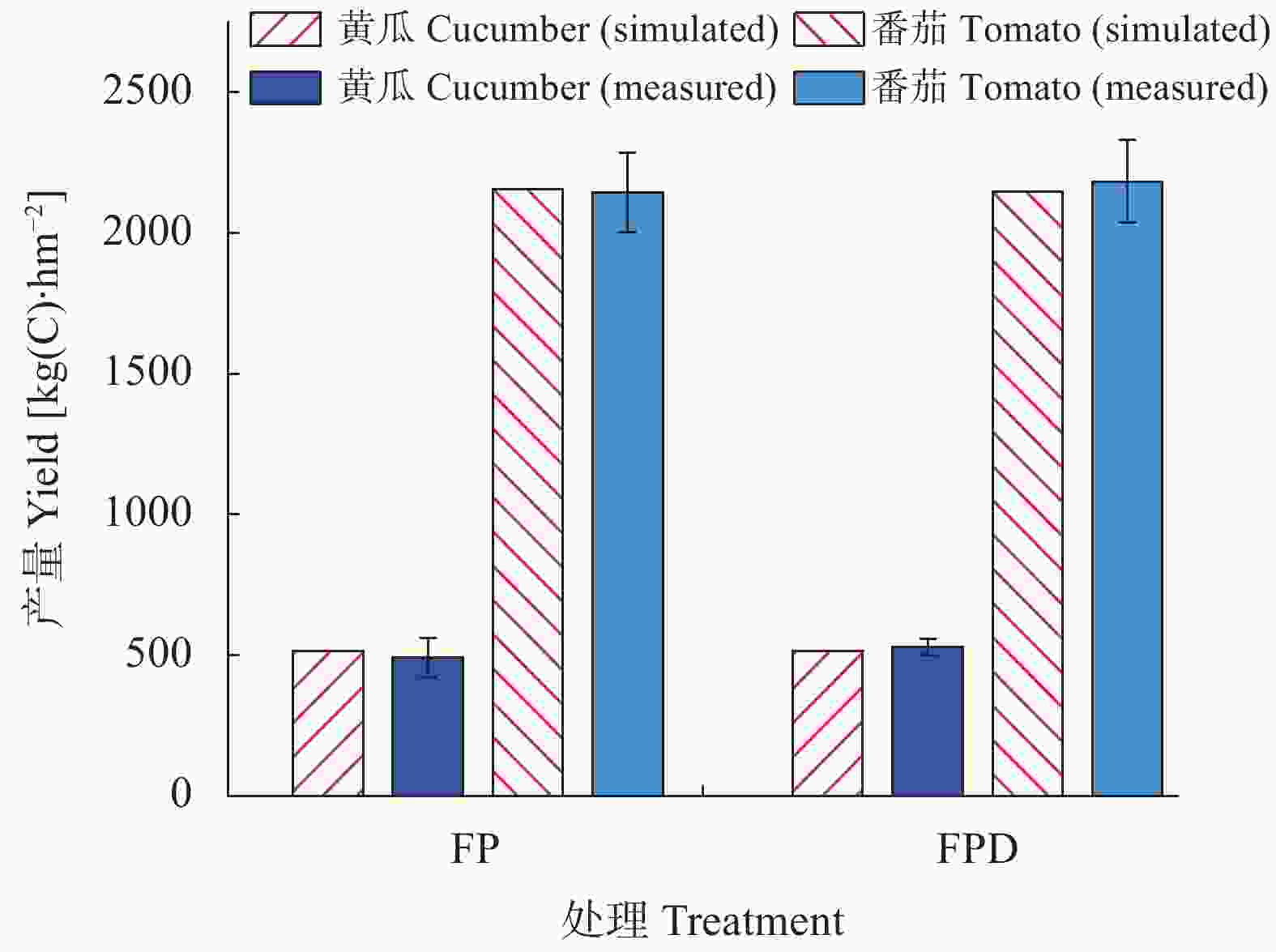
 下载:
下载:
